Trees Birds Mammals Fish Amphibians Reptiles
Wild Algarve
Bookshop
Phylum: Basidiomycota - Class: Agaricomycetes - Order: Agaricales - Family: Strophariaceae
Distribution - Taxonomic History - Etymology - Identification - Culinary Notes - Reference Sources
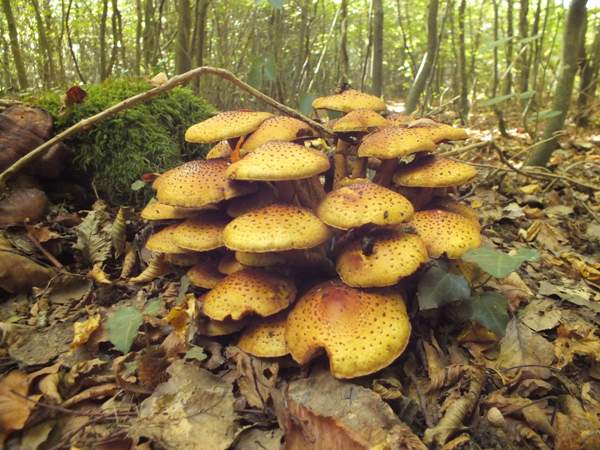
Pholiota adiposa, an uncommon species occurring
most often on dead or dying Beech trees, usually produces dense tufts with conjoined stem bases low down on trunks or on stumps and large fallen branches.
Distribution
An occasional find throughout Britain and Ireland, Pholiota adiposa is most often seen in Beech (Fagus sylvatica) woodland but can also occur on poplars, oaks and other kinds of broadleaf dead timber. This species also found in northern and central mainland Europe and has been recorded in parts of North America.
Taxonomic history
Described in 1786 by German naturalist and mycologist August Johann Georg Karl Batsch, who named it Agaricus adiposus - a name subsequently sanctioned by Elias Magnus Fries - this scalycap mushroom was moved to the genus Pholiota by another famous German mycologist, Paul Kummer, thus establishing its currently-accepted scientific name as Pholiota adiposa.
Synonyms of Pholiota adiposa include Agaricus adiposus Batsch and Dryophila adiposa (Batsch) Quél.
Etymology
The generic name Pholiota means scaly, and the specific epithet adiposa comes from the Latin noun adeps meaning lard, or grease - a reference to the greasy cap surface of this woodland mushroom.
Identification guide
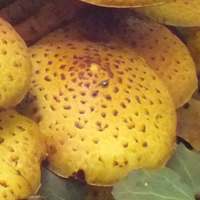 |
Cap
5 to 10cm in diameter, convex eventually flattening; bright yellow and with
a greasy surface that is slimy in wet weather. Brown scales from veil fragments cling to the cap
most densely towards the centre |
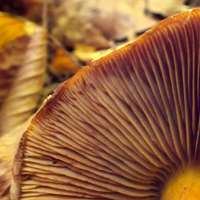 |
Gills
The crowded adnate gills are pale yellow when young, turning red-brown as the
spores develop. |
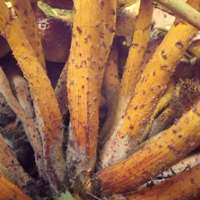 |
Stems
Cylindrical, 5 to 10mm in diameter and 2.5 to 6cm tall; yellow becoming rust-brown
towards the base; surface usually covered sparsely with upturned brown scales (fragments
of the partial veil). The stems often join where they are attached to the substrate. |
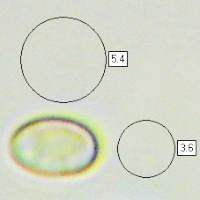 |
Spores
Ellipsoidal, smooth, 5-6.5 x 3-4μm.
Spore print
Reddish-brown. |
Odour/taste |
Odour faint, pleasant but not distinctive; taste not distinctive. |
Habitat & Ecological role |
Mostly seen on stumps, dead trunks and fallen large branches of
Beech, but can also occur on oaks, poplars and other broadleaf hardwoods.. |
Season |
Late summer and autumn in Britain and Ireland. |
Similar species |
Pholiota squarrosa is usually paler with much larger cap and stem scales.
Pholiota alnicola has few scales and much larger spores; iut grows on Alder trunks.
Pholiota aurivella has pale stems and much larger spores with distinct germ pores.
Some forms of Armillaria
mellea, the Honey Fungus, are scaly but their spore prints are
white rather than brown and the gills do not darken significantly with
age.
Kuehneromyces mutabilis can be very similar, although its cap is usually two-toned. It also has a
more obvious sign zone and a dark tan stem below the ring zone; its gills
are ochraceous when young, becoming cinnamon at maturity. |
Culinary Notes
Despite their attractive appearance, these and other scalycaps (Pholiota species) are definitely not edible mushrooms, although in the past some members of this genus were considered to be so.
Reference Sources
Fascinated by Fungi, 2nd Edition, Pat O'Reilly 2016, reprinted by Coch-y-bonddu Books in 2022.
British Mycological Society (2010). English Names for Fungi
Funga Nordica, Henning Knudsen and Jan Vesterholt, 2008.
Dictionary of the Fungi; Paul M. Kirk, Paul F. Cannon, David W. Minter and J. A. Stalpers; CABI, 2008
Taxonomic history and synonym information on these pages is drawn from many sources but in particular from the British Mycological Society's GB Checklist of Fungi.
Top of page...
Fascinated by Fungi. Back by popular demand, Pat O'Reilly's best-selling 450-page hardback book is available now. The latest second edition was republished with a sparkling new cover design in September 2022 by Coch-y-Bonddu Books. Full details and copies are available from the publisher's online bookshop...